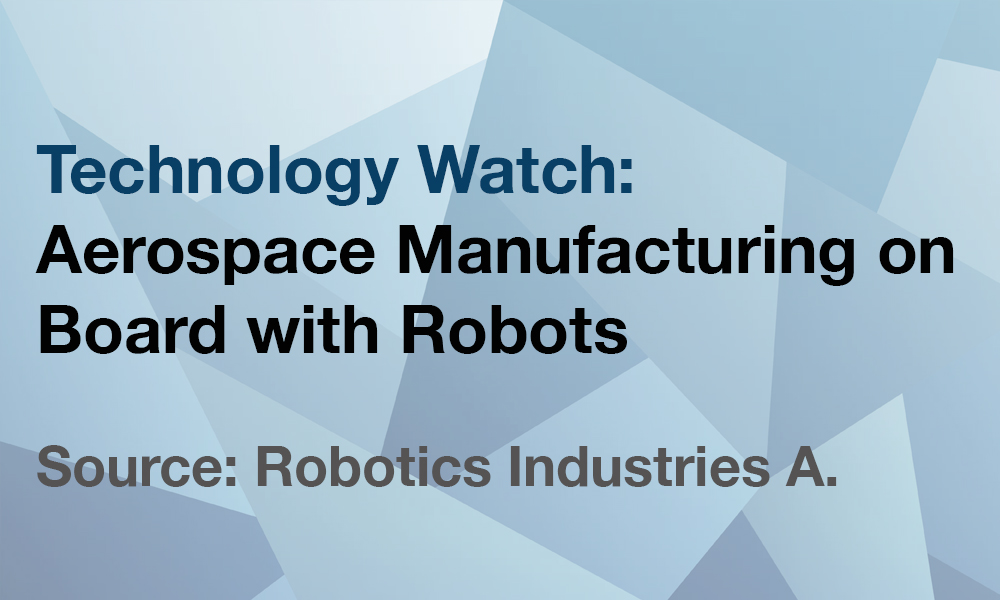Source: Robotics Industries Association
Since the Wright Brothers’ first flight in 1903, to the SpaceX launch and land in 2015, aerospace has shot high. Lucky for us. Because the original biplanes were basically big kites, made from wood, wire and linen literally stitched together by teams of seamstresses. Yes, before Rosie the Riveter there was Sally the Seamstress, or Ida Holdgreve.
Aircraft are still “stitched” together, but now their metallic and composite skins are riveted and bonded. And increasingly, those modern-day seamstresses are robots.
With their renowned repeatability, and now greater rigidity and accuracy, robots are the lower-cost tools of choice for many aerospace manufacturing operations. Drilling, fastening, sealing, painting, and composite part production all benefit. Coupled with additive manufacturing and soon, a new rivet-free technology that could transform how aircraft is made, robots are helping to shape the aerospace factory of the future.
The next time you board a flight and prepare to step over the threshold, take a glance down the side of the fuselage. You may have an entirely new appreciation for all the craftsmanship and technology that go into aircraft production.
Automating Aircraft Production
With the aircraft backlog high, competition hot, and many clean-sheet aircraft in the works, aerospace manufacturers are hard-pressed to automate. Ergonomic challenges for workers, and productivity and quality demands are fueling the charge. OEMs and their top-tier suppliers are deploying robots to maximize efficiency and hike their rates.
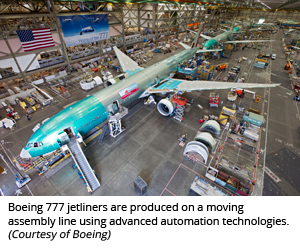 William Boeing started Boeing Airplane Company in 1916. Today, Boeing is a leading manufacturer of commercial jetliners and defense, space, and security systems. With corporate offices in Chicago, Boeing employs more than 165,000 people across the U.S. and in more than 65 countries. As Boeing celebrates its centennial, the world’s largest aerospace company continues to push the envelope with a series of strategic advanced manufacturing initiatives and projects, many of which include automation.
William Boeing started Boeing Airplane Company in 1916. Today, Boeing is a leading manufacturer of commercial jetliners and defense, space, and security systems. With corporate offices in Chicago, Boeing employs more than 165,000 people across the U.S. and in more than 65 countries. As Boeing celebrates its centennial, the world’s largest aerospace company continues to push the envelope with a series of strategic advanced manufacturing initiatives and projects, many of which include automation.
“When looking at implementing automation we are focused on areas that will improve employee safety by removing ergonomic risks,” says Boeing spokesperson Nate Hulings. “We also look at build functions where automation can enhance quality and productivity. Advanced manufacturing processes will enable us to meet increasing future rates by improving productivity and improving flow.”
Boeing was an early adopter of robots for painting aircraft, and has facilities around the globe that deploy drilling and fastening robots on its aircraft assembly lines.
Drilling Robots Fly Commercial
Robot deployment is saving aviation workers from repetitive stress injuries and reducing costly rework. Automated drilling and fastening machines that crawl along the fuselage are helping aircraft manufacturers reduce backlogs. These robotic devices are distant cousins to the articulated industrial robots starting to populate aerospace drilling and fastening operations.
“Fastening is to the aerospace industry what welding is to the automotive industry,” says Dan Friz, Director of Business Management at KUKA Systems. “It’s the core technology for the joining process. When you start looking at large aircraft like the Boeing 777, that’s in the neighborhood of a million-plus fasteners per aircraft.”
KUKA Systems North America LLC, based in Clinton Township, Michigan, is a global integrator and supplier of automated systems for the automotive, aerospace, and alternative energy industries. Sister company KUKA Robotics designs and builds industrial robots.
Fuselage Upright, Robots on the Job
Boeing worked closely with KUKA Systems to develop an advanced automated manufacturing process for its wide-body commercial airliners. Called Fuselage Automated Upright Build (FAUB), the robotic production line assembles the forward and aft fuselage sections of the Boeing 777 jetliner. Several aspects of this robotic assembly line make it unique.
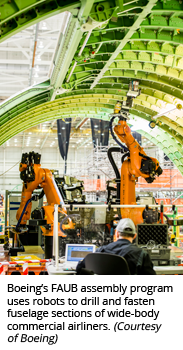 Traditionally, the riveting process is done manually with mechanics positioned on both sides of the fuselage, performing repetitive movements that place considerable strain and impact stress on their shoulders, arms and hands. In a costly and time-consuming process, the massive fuselage must be rotated so mechanics can ergonomically access the riveting locations.
Traditionally, the riveting process is done manually with mechanics positioned on both sides of the fuselage, performing repetitive movements that place considerable strain and impact stress on their shoulders, arms and hands. In a costly and time-consuming process, the massive fuselage must be rotated so mechanics can ergonomically access the riveting locations.
In the FAUB workspace, the fuselage remains “upright” throughout the entire build. Because unlike humans, robots can work at any angle.
According to Boeing, the process also simplifies the build by using determinant assembly (part-to-part indexing) for panel and floor indexing. Determinant assembly provides for a quicker process by using features of the parts, such as drilled holes, to quickly align components without requiring additional tooling or fixtures.
Workers begin the build by loading and assembling the floor beams and frames, and then synchronous robots work on the fuselage panels, both longitudinal and circumferential splices. Working from both sides of the fuselage, KUKA robots work in pairs to concurrently drill and countersink holes, insert fasteners, and complete the riveting.
This process is called drilling, filling and bucking. The robot on the exterior side of the fuselage is drilling the hole, inserting the fastener (filling the hole), and hammering it, while the robot on the interior is acting as an anvil (bucking) for the hammered fastener to properly deform (called ‘upset’) and create the rivet.
KUKA Systems also developed the multifunctional end effector for the robot, which clamps the different material layers that make up the fuselage, and then drills, fills and bucks – all with one end-of-arm tool.
The KR QUANTEC robots are positioned along the fuselage with the aid of mobile platforms also made by KUKA Robotics. The KUKA KMP omniMove achieves autonomous motion in any direction without the need for artificial markings on the floor. Proprietary software called KUKA Navigation Solution uses data from the onboard safety laser scanners and wheel sensors to create a map of its surroundings using SLAM (Simultaneous Localization and Mapping) technology.
Tight software and hardware integration achieve a high degree of precision and flexibility for this advanced aircraft assembly process. We first reported on the FAUB program in our January 2015 forecast article when we covered robot-robot collaboration as a growing trend. Watch the FAUB assembly system in action, courtesy of Boeing.
The FAUB production line is in residence at Boeing’s mammoth factory in Everett, Washington. The aircraft manufacturer is currently using the process at a low rate of initial production. When at full rate, several pairs of KUKA robots will work in tandem installing approximately 50,000 fasteners per fuselage.
According to Boeing, the first 777 assembled with the FAUB process was delivered in December 2015. Eventually, the robotic assembly system will be drilling, filling, and bucking the fuselages of the new Boeing 777X aircraft when it enters production in 2017.
Boeing reports that the new automated process helps with areas that cause the greatest ergonomic issues, but expects that other residual benefits will follow, including quality, cost and flow. Quantifiable performance metrics will be made public when production reaches full rate, which is anticipated within a year.
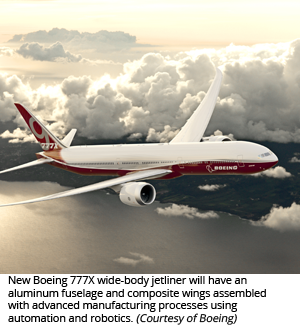
Robot Accuracy, Not an Oxymoron
Robots are renowned for their repeatability. But when it comes to accuracy and precision, especially at the level required by the aerospace industry, robots have always taken a backseat to machine tools. One company set out to change that.
Located a stone’s throw from the Boeing Everett Factory is Electroimpact Inc., one of the largest integrators of aircraft assembly lines in the world. Customers include all the major aircraft manufacturers, many of which use the integrator’s custom automated systems for assembling large-scale aircraft structures. Electroimpact also integrates robotic systems for drilling and fastening of aerostructures, and also robotic automated fiber placement (AFP) systems used in composite aircraft production.
Remember the fuselage-hugging fastening device we showed you earlier? Yes, Flex Track. Same company. But what else would you expect from an organization 600-plus engineers strong. Electroimpact holds more than 20 patents for various automated systems and processes used in the aerospace industry. We’ll explore their robotic AFP technology later.
“We have robots on five continents doing drilling applications,” says Russell DeVlieg, Robotics Systems Lead for Electroimpact in Mukilteo, Washington. “The biggest is Boeing where we have 787, 777 and 737 applications for drilling. We have drilling systems at Northrop Grumman, Bombardier, Embraer, and many others. We have robots in China at XAC (Xi’an Aircraft Company Limited).
“These are typically components like flaps, wings, and fuselage systems,” he continues. “We touch many of the major airplanes with a robot.”
DeVlieg says 2015 was a booming year for both robots and custom machines. The integrator reports that roughly 85 percent of their robotic system sales are for drilling, or drilling and fastening, while about 10 percent are for AFP, with the remainder attributed to pick-and-place and specialized applications. Used for both drilling and AFP processes, a patented system developed by Electroimpact is bringing more robotics to the factory floors of aircraft OEMs and their top-tier suppliers.
“We’ve been using robots for drilling and fastening operations since 2001,” says DeVlieg. “When we started out, we used an off-the-shelf robot and its controller.”
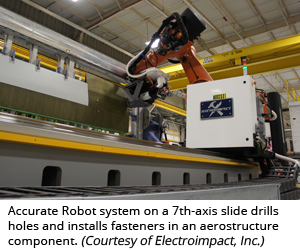 He says this off-the-shelf solution was fine for applications that didn’t require tight positional tolerances. But they quickly realized that in order to expand the application base for robotics, they would need a solution with much higher accuracy. Enter Electroimpact’s patented Accurate Robot technology.
He says this off-the-shelf solution was fine for applications that didn’t require tight positional tolerances. But they quickly realized that in order to expand the application base for robotics, they would need a solution with much higher accuracy. Enter Electroimpact’s patented Accurate Robot technology.
“We had the idea for a while to put secondary feedback on each of the robot joints, because we recognized that backlash was a major contributor to the robot’s inaccuracy,” explains DeVlieg, a mechanical engineer and the technology’s inventor. “One way to remove backlash is to control the output of an axis rather than its input, so we put sensors on the output of each axis and controlled that. We closed the position loop around it.”
DeVlieg says they still use an off-the-shelf articulated robot, but they add the secondary feedback system and ditch the robot controller for a Siemens CNC controller, which handles all of the process functions, robot motion, and positional accuracy.
Electroimpact also creates their own kinematic model for each robot to compensate for differences in machining and assembly tolerances common to volume-manufactured products. They plug that kinematic model into the CNC controller along with the data from the secondary feedback system to control the position of the tool, in this case a multifunction drilling end effector or an AFP head. While only KUKA robots have been used to date, DeVlieg says they can apply it to any robot.
“We have it down to an art,” says DeVlieg. “Taking the data and crunching the numbers to produce an Accurate Robot takes about 2-1/2 hours, and it’s all automated. We’re not measuring, or feeding back information to do offsetting. This is all real-time accuracy.”
Affordable Machine Tool Performance
The patented system achieves on-part accuracy of +/- 0.25 mm. Electroimpact was able to achieve the performance and control of a custom machine tool, while maintaining the flexibility and low cost of an articulated robot. DeVlieg says this aligns with the needs of the growing number of top-tier aerospace suppliers that make up Electroimpact’s customer base.
“It used to be Boeing made everything. Now we’re dealing with Tier 1 and Tier 2 suppliers that don’t have the big budgets. They’re still making components for Boeing and for Airbus, so they want to get automation on their shop floors, but it needs to be something they can afford. The robot is, first and foremost, affordable.”
Robots are also in a league of their own for flexible articulation and range of motion.
“For instance, you can take a robot and drill an entire leading edge of a wing,” says DeVlieg. “You’re essentially going around 180 degrees. You’re drilling in front, on top, and then around the backside of a part all with one machine, rather than trying to design something custom to do that.”
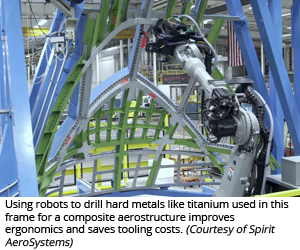 Leading aerospace suppliers are taking a second look at robots for their enhanced capabilities and tried-and-true flexibility.
Leading aerospace suppliers are taking a second look at robots for their enhanced capabilities and tried-and-true flexibility.
“There’s been an evolution of how robots are used in the aerospace industry,” says Curtis Richardson, Associate Technical Fellow at Spirit AeroSystems, headquartered in Wichita, Kansas. “The robots that were in our plants 15 or so years ago were targeted at non-precision applications. Since then, because the capability of industrial robots has improved, we’ve been able to use them for many other processes.”
With facilities across the U.S., Europe and Southeast Asia, Spirit AeroSystems manufactures aerostructures for many of the world’s major aerospace OEMs, including Boeing, Airbus, Bombardier, Rolls-Royce, Mitsubishi, and Bell Helicopter. Core components include fuselages, large wing structures, nacelles, pylons, fan cowls, thrust reversers, and systems integration. Spirit AeroSystems has more than 40 robots in production applications around the world.
“We’re using robots in a variety of manufacturing processes, drilling and fastening probably being two of the prime examples,” says Richardson. “But we’re also using robotics for painting and coating applications, for inspection processes, and for material handling.”
Robots, such as the Yaskawa Motoman (pictured), drill holes in the titanium and aluminum structures that support the composite skins for the nose section of the Boeing 787 jetliner. Spirit AeroSystems also uses robots to apply wear-resistant coatings on structural aircraft components that surround or support propulsion systems, such as nacelles and engine pylons.
The aerostructures manufacturer currently uses custom automation, or large gantry systems with multi-axis heads, for AFP processes on composite parts for the Airbus A350 XWB and Boeing 787 jetliners. But Richardson says that the use of robots for AFP is an area of interest.
“At least until five or ten years ago, the vast majority of automation that existed in aerospace manufacturing was relegated to custom automation,” he says. “The trend now has been more towards industrial robotics as a valid alternative to larger, custom automation.”
That plays right into one supplier’s wheelhouse. Electroimpact provides both custom AFP machines and robots for composite aerostructure fabrication.
Robotic AFP for Composite Aerostructures
Composite materials have been integral to the aviation industry for some time now. Coveted for their structural strength and lighter weight compared to metallic materials, composites contribute to better fuel efficiency and reduced airplane emissions. AFP (automated fiber placement) processes use computer-guided robotics to lay up one or several layers, called tows, of carbon-fiber tape onto a mold to create a composite aerostructure.
“The use of AFP in the industry is increasing dramatically, and Electroimpact as a company is doing more AFP work and it’s becoming a larger portion of our total market share,” says Kyle Jeffries, AFP Lead at Electroimpact.
He notes that most of this work is done with custom automated machines like Electroimpact’s AFP systems for the Boeing 777X.
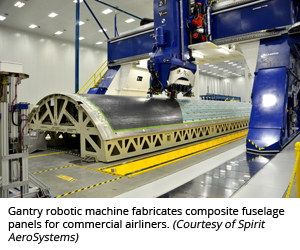
“The rigid machines we build are like the race cars, or the Ferraris, of AFP. If someone comes to us with an aircraft structure that they need to build for the next 30 years for the life of an aircraft program, they will pay for a lot of customization. To squeeze every bit of efficiency out of it, they will optimize heavily for that specific process and shape. A lot of our niche in AFP is building Ferrari-style, high performance machines that are tailored to fit around a specific aerostructure part.”
Robotic AFP is still an emerging trend. Jeffries says their first AFP robot went into production in 2013 for fabricating Airbus A350 XWB composite stringers and frames. All of Electroimpact’s robotic AFP systems take advantage of its Accurate Robot technology described previously.
Compared to their heavy machine tool counterparts, the primary advantages of AFP robots are overall cost and lead time. AFP robots are also lighter, so concrete foundation requirements are less stringent. Their footprint is also much smaller.
Accustomed to high-duty cycle work in automotive plants, robots tackle what is typically low-duty cycle AFP work without breaking a sweat. Built to run 24/7 at breakneck speeds for 15 years or more, robots have long maintenance intervals in the low-duty cycle AFP world.
“When you talk about operational costs and ongoing costs with a customer, robotic AFP systems are very economical,” says Jeffries. “It’s all about money.
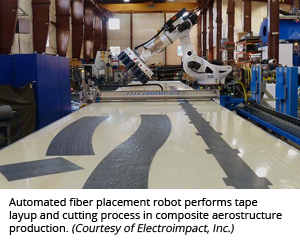 “A lot of times we’re working on parts that are simply way outside the volumetric reach of a robot. But if a customer’s part fits inside the reach of a robotic arm on a track, then we always look at that pretty hard.
“A lot of times we’re working on parts that are simply way outside the volumetric reach of a robot. But if a customer’s part fits inside the reach of a robotic arm on a track, then we always look at that pretty hard.
“We do a lot of lower curvature parts for aerospace,” continues Jeffries. “With a low curvature part, you can easily set an 8-foot-wide part next to the robot and the part can have contours that are 2 to 3 feet deep, and then as long as you’re willing to put a track down, the length can essentially be infinite. One of our robots has a work volume that is 8 feet wide, 2 feet deep, and 60 feet long.”
This video demo shows an AFP robot on a track laying down crisscrossing tows of carbon fiber tape, which are then segmented by a ply-cutting gantry. The glow you see is the heating element that makes each layer tacky so subsequent layers bond easily.
Couple a track-mounted AFP robot with a rotary positioner and you have a mesmerizing dance. Check out this AFP application for spacecraft. Again, like Electroimpact’s drilling robots, these AFP robots are all CNC controlled. Jeffries says they are using Siemens’ built-in functions for axis coordination as well.
Now watch experts at NASA’s Marshall Space Flight Center explain how an AFP robot will be used to build the largest composite rocket parts ever made.
Robotic Nacelle Perforation
While the sheer size of some aircraft often dictates the need for manual labor or massive machines that span the width of subassemblies, it’s the graceful contours of aerostructures that lend themselves so well to flexible articulated manipulators.
“The design of a robot is really amazingly efficient,” says Spirit AeroSystems’ Richardson. “An industrial robot is a very small package, but it has an enormous range of motion and you can do a lot of things with it. That’s been one of the big enablers. If you have a gantry, you have a defined and therefore limited range of motion, and you’re locked into that. It’s very difficult and cost-prohibitive to modify later. It’s not inherently scalable in the same way that robots are.”
He describes a robotic process for the nacelles (jet engine housings) of the Boeing 737 airliner.
“That particular application is a great showcase for robots because it’s a result of increased robot capability that made the process possible. It’s a very high-force application.”
The robotic process uses a proprietary method to create perforations in the inner layer of the composite nacelle to aid in engine noise suppression.
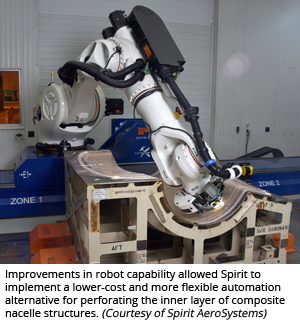
“We’ve been doing that process for more than 20 years,” says Richardson. “Until the robot was introduced, it was done with custom automation. What the robot brought to the table was a lower-cost alternative. It saved us close to $4 million compared to doing the same thing with custom automation. It allowed us to have a smaller footprint, almost a 50 percent reduction. And it gave us more useable capacity.”
With this robotic solution, Spirit AeroSystems is able to work in two processing zones. While the robot is working in one zone, workers are able to prep parts or complete post-processing work in the other zone.
“There’s no downtime switching between parts,” says Richardson. With the custom automation solution, all the prep work had to be done offline and then brought into the machine, resulting in downtime. It was a much more sequential flow. We can do things in parallel with the robot.”
This dual-zone working area is made possible with a flexible safety approach. Rather than having the robot fenced off with hard guarding, safety laser scanners monitor the robot’s working zone and in conjunction with safety technology available on the latest machine controllers, robot motion is slowed or stopped to prevent unintended contact. For more on this flexible safety paradigm, see The Shrinking Footprint of Robot Safety.
“The workers around and adjacent to the machine are safe, but we’re also able to make the process more efficient by not having gates that would be in the way of product flow,” adds Richardson.
Robots are not only flexible, their portable, especially compared to large gantry machines or other custom automation. This next robot reaches new heights in mobility.
Robots Elevate Business Jet Assembly
Serious business travelers trust corporate jets to get them from point A to point B reliably. Business jet manufacturers rely on automation to get from design to build efficiently. Robotic drilling goes mobile in this automation solution.
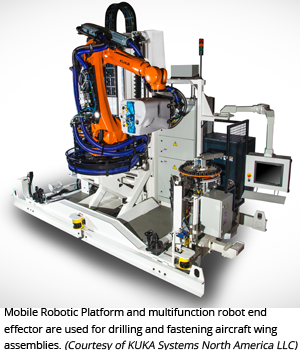 KUKA Systems integrated a mobile robotic drilling and fastening platform for Gulfstream Aerospace. Friz says they have two mobile platforms at the business jet manufacturer’s facility in Savannah, Georgia.
KUKA Systems integrated a mobile robotic drilling and fastening platform for Gulfstream Aerospace. Friz says they have two mobile platforms at the business jet manufacturer’s facility in Savannah, Georgia.
The mobile platform supports a KUKA robot equipped with a multifunction end effector to reach different drilling locations on the airframe. It also allows for mobility around the factory floor.
This video demo shows the mobile robotic platform and multifunction end effector in action.
The technology was developed by Alema Automation, which was acquired in 2014 by KUKA AG, parent company to the robotics and systems divisions. KUKA Systems built a new facility in France to house R&D and production for the aerospace group.
The mobile robotic platform is used for wing assemblies of the new Gulfstream G500 and G600 business jets. The robots drill primarily on the wing and horizontal stabilizer structures of the aircraft, including sections containing titanium that are very difficult to drill manually.
Drilling Robots in the Fight
Fighter jets are getting in on the action, too. KUKA Systems was responsible for integrating five robotic drilling stations for Northrop Grumman’s F-35 Lightning II Center Fuselage Integrated Assembly Line (IAL). Northrop Grumman Aerospace Systems’ facility in Palmdale, California received the 2013 Assembly Plant of the Year award for the IAL’s ground-breaking approach to airframe assembly.
Previously a manual process, the robots perform drill-only operations for both forward and aft inlet ducts. Automating the process has removed ergonomic concerns and unsafe working conditions for the aircraft mechanics.
Friz says FANUC robots were chosen for this particular process, mainly for their reach capabilities. Before joining KUKA Systems in 2007, Friz worked for Lockheed Martin on the F-35 Lightning II program.
“I am one of the few who has worked with almost every major structural assembly of the F-35. When I came to KUKA and was able to work on the center fuselage, that covered the entire gap, from nose to tail.”
The automation for the F-35 fighter jet might make the automotive assembly line envious. Watch it in action.
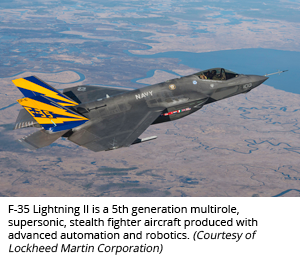 From nose to tail, robots are making headway in a variety of advanced manufacturing scenarios in the aerospace industry.
From nose to tail, robots are making headway in a variety of advanced manufacturing scenarios in the aerospace industry.
Sealing Wing Spars
Scott Melton is Director of Sales–Western Region for FANUC America Corporation, which is headquartered in Rochester Hills, Michigan, and is one of the largest robot manufacturers in North America. From his home base on the West Coast, Melton works closely with major aerospace manufacturers such as Boeing, Northrop Grumman, Lockheed Martin, and SpaceX.
He says FANUC robots are used in the aerospace sector for drilling and riveting, coating and paint removal, welding of aluminum structures, and polishing. Robots are also used for sealing applications on aerostructures such as spars, the main load-bearing supports for aircraft wings.
“The types of robots used in sealing are medium-sized robots like our M-710iC series,” says Melton. “They have the payload and reach that’s needed, because the dispensing equipment does have some weight to it. You can do a fairly good-sized part with that robot and cover a fairly large range of motion.”
He says machine vision is often used to locate the joints and guide the robot along the seam. Robotic sealing is a mainstay in the automotive industry, where the process has been perfected in high-volume manufacturing for years. Watch this team of assembly-line FANUC robots pop the hood and the trunk before applying sealer into the nooks and crannies of this unsuspecting car.
Now imagine a similar process applied to the spars for aircraft wings. (But with no “outside” cameras allowed.)
Robotic sealing isn’t the only automation solution borrowed from the automotive industry. Painting robots have it covered.
Painting Robots for Aerostructures
The automotive industry has perfected the art of robotic painting over generations. More recently, an aerospace pioneer borrowed a move from their land-based cousin’s playbook.
Boeing adopted robotic painters for the wings of its 777 commercial airliner. The robots brought a long checklist of improvements to the aircraft manufacturer’s paint line, including faster paint application, improved finish quality, and marked weight savings. Watch this dynamic duo in action.
Now robotic painting has expanded to other parts of the aircraft, to the fuselage, tail sections, nose, and even the doors. Kawasaki Heavy Industries recently announced a contract with Boeing to manufacture cargo doors for the new 777X airliner. Kawasaki will establish an automated production line for joining and painting the composite cargo doors at its division in Lincoln, Nebraska, home to Kawasaki Motors Manufacturing Corporation (KMM).
Probably known best for its motorcycles or jet skis, Kawasaki represents so much more in the world of manufacturing. It’s a multinational conglomerate of shipbuilders, engine makers, precision machinery designers, roboticists, and aircraft producers. Take a look.
“We have an entire aerospace division in Japan that is solely responsible for manufacturing components for companies that build airplanes. But we also build our own helicopters and training jets that are sold by Kawasaki Heavy Industries, and that’s evolved from our roots as a shipbuilder since the 1870s,” says Ed Minch, Director of Sales & Engineering–Automotive/General Industries at Kawasaki Robotics (USA) Inc. in Wixom, Michigan.
“Because we have our own aerospace division and we provide the tooling for that, we have the opportunity to implement new technologies that ultimately can be sold and packaged to the aerospace manufacturers themselves,” adds Minch.
One of those technologies is Kawasaki’s long-established expertise in robotic painting. Used in its own plants and around the world at customers’ facilities, specialized explosion-proof robots paint everything from cars, motorcycles, and furniture, to high-speed bullet trains.
Doubling the Work Envelope
The automated painters slated for installation in KMM’s new Boeing 777X production line in Nebraska will be the Kawasaki KJ314 model, a 7-axis pedestal robot designed for the big leagues. The 7th axis is an additional waist, allowing the robot to rotate vertically, along with its horizontal rotation.
“For painting large parts, that more than doubles my reach capability of a single robot,” says Minch. “Doubling the work envelope of the robot is a significant advancement in being able to continue the paint path on large parts. The robot can be positioned on an elevated pedestal or linear traverser and completely rotate 180 degrees down, maintaining its work envelope all the way through that range of motion (one continuous movement).”
Practical applications for large-part painting include Class 8 trucks, locomotives, helicopter fuselages, and aircraft wings. Placed on an auxiliary linear axis, the robot could be used to paint commercial aircraft fuselages. Minch says the target is for very large structures that would typically require multiple standard robots.
“It comes down to the enormity of the parts,” he says. “They’ve been trying to implement automated painting technology in the aerospace market for a long time by applying standard paint robots used on cars. But you have to get very creative with the auxiliary axes to get a robot up high and move them from left to right. Now we have a robot that doesn’t need that. It has a work envelope big enough to get up and around without an additional vertical lift.”
Kawasaki’s new robotic paint line for Boeing is expected to be painting cargo doors by May 2017.
Painting, Material Handling in One
Minch describes another application for an aerostructure subassemblies manufacturer in Canada that is painting 9-foot-long aluminum body-to-wing frame structures for a commercial airliner.
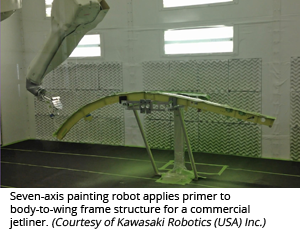 “They’re using our KJ314 for both material handling and painting in a single booth,” explains Minch. “They have to apply a Teflon coating (and primer coat, as pictured) to these structures to protect them from the elements over the lifespan of an airplane. The paint material is very expensive, as are the parts, so there’s no room for error.”
“They’re using our KJ314 for both material handling and painting in a single booth,” explains Minch. “They have to apply a Teflon coating (and primer coat, as pictured) to these structures to protect them from the elements over the lifespan of an airplane. The paint material is very expensive, as are the parts, so there’s no room for error.”
Typically, a process such as this would incorporate an automated system where the parts are shuttled into the paint booth one at a time for painting. But not with this robot.
“That’s the beauty of it,” says Minch. “The manufacturer didn’t want to have to provide a conveyor and didn’t want the workers to have to walk into the paint booth. The robot’s work envelope is so large that it can take the part from one side of the booth, put it into a paint fixture in the middle of the booth, paint it, and then place it on the other end of the booth for the operator to remove and put into their curing oven.
“What used to take them 8 hours in a manual process now they can do in 3 hours,” he adds. “This application has gone so well that they’re looking at other applications for robots.”
While some robots are spraying it on, others are taking it off.
Robotic Painting and Paint Removal, Big Time
Paint and coating removal is a nasty, hazardous job. Perfect for robots. That’s why the U.S. Air Force contracted Southwest Research Institute (SwRI) to develop a robotic paint removal system for fighter jet maintenance.
The Robotic Depaint System (RDS) uses 9-axis robots that spray plastic blasting media to strip paint and surface contaminants from defense and tactical aircraft. RDS is designed for the F-15, F-16, and F-22 fighter jets, according to Clay Flannigan, Assistant Director of Robotics and Automation Engineering at SwRI in San Antonio, Texas. He says the systems have been in service for nearly 25 years.
But SwRI had its sights set big – much bigger.
RDS is constrained to a track. SwRI knew that if they wanted to cost-efficiently apply this concept to larger aircraft like commercial airliners and cargo jets, the robot would need to go mobile. Before scaling up, SwRI researchers proved out the technologies in small scale by using a Metrology Referenced Roving Accurate Manipulator, or Mr. ROAM.
Mr. ROAM consists of a 7-axis robot arm from Yaskawa Motoman, which is mounted on an omnidirectional base with Mecanum wheels that allow the mobile manipulator to pivot on its axis and move in any direction, even sideways. The system is outfitted with a host of on-board sensors and advanced software for positional accuracy and coordinated motion.
Watch Mr. ROAM and the jet fighter paint removal robots in action, courtesy of SwRI. Now imagine an RDS-style robot 5 stories tall, equipped with a laser ablation system, and mounted on an autonomous mobile platform.
The mobile Laser Coating Removal Robot (LCR) will be 50 feet tall, have 8 axes, and be able to reach 90 feet in the air, making it ideal for laser coating removal and eventually painting and inspection of commercial airliners. Dutch startup LR Systems B.V. is funding the project to commercialize the technology and offer it initially to the airliner MRO (maintenance, repair and overhaul) market. SwRI’s Flannigan says LCR is slated for deployment in mid-2017.
Hey, Guinness World Records, you may have a new candidate for the largest (or at least, the tallest) robot on the planet. Move over Tradinno the dragon. These new robots will shoot laser beams.
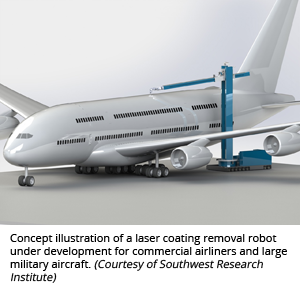
Mobile Robots and Human-Robot Collaboration (HRC)
With or without lasers, mobile robots are raising eyebrows wherever they roam. The mobility and flexibility afforded by mobile autonomous robots, AGVs, and omnidirectional platforms are a growing trend in the aerospace industry.
Systems that slowly convey the aircraft along the assembly line and mobile platforms that move robots and other automated equipment into position around the aircraft, or even to other parts of the factory, are popping up in various form factors. Another closely related trend is human-robot collaboration, a major area of exploration for the aviation sector.
The VALERI project assembled a consortium of European research institutions and industrial partners to develop mobile autonomous robots designed to assemble aerospace components and work hand in hand with their human coworkers, the initiative’s vision for the factory of the future.
Boeing was just granted a patent for a fully automated fuselage manufacturing plant, the concept being that both airplanes and robots will be on the move.
Boeing Research & Technology (BR&T) is the advanced, central research and development organization at Boeing. To ensure that technologies are ready when needed, BR&T conducts its own development and also works with top government, private, and university research centers around the world to solve the aerospace industry’s toughest challenges.
BR&T participated in the rigorous certification process for the RIA Certified Robot Integrator program and is the only aircraft manufacturer among the 30 high-caliber integrators.
“The external assessment of our knowledge, skills, and abilities as system integrators has provided greater perspective on our strengths, and where we need to improve,” says Hulings on behalf of Boeing. “Our strategy is to self-integrate where the technology is highly leveraged with intellectual property and where Boeing wishes to prevent information from leaving the company. Boeing became a certified integrator to ensure our internal customers that the team developing technology and integrating the system into production are qualified to bring the technology home.”
The aircraft manufacturer reports that it is currently using power and force limiting collaborative robots both for development projects, as well as production operations.
“Our current focus is on using them in force controlled and shared workspace applications (mechanics and robots working in the same space, but not on the same tasks),” says Hulings. “We are exploring opportunities and technologies that can enable true collaborative operation (the robot and mechanic working together to complete a task). We see tremendous opportunities and advantages to using this new robot technology. In particular, moving from position-controlled applications to force- and impedance-controlled applications allows us to more closely mimic how people do work through touch and feel.”
Meanwhile, rival Airbus has posed a challenge. Robots will no doubt answer the call.
KUKA Systems is looking into applications for more human-robot collaboration.
“There are plenty of opportunities,” says Friz. “We are trying to involve the LBR iiwa robot, because there are a lot of things we can do especially in aerospace to take advantage of the sensitivity and the safety of the iiwa robot.”
Friz is referring to the KUKA LBR iiwa robot. This lightweight robot has power and force limiting technology that enables safe human-robot collaboration. Currently, KUKA Systems is developing a robotic process and special end effector for automating nut installation on fasteners used in airframe assembly.
FANUC introduced the industry’s first 35-kg payload collaborative robot in 2015. The FANUC CR-35iA robot is force limited and designed to work safely alongside human workers without the need for safety fences. Already in production at General Motors, the robot was developed to help manufacturers solve ergonomic challenges by handling applications that are physically demanding for humans, such as heavy lifting. Watch the green FANUC in action.
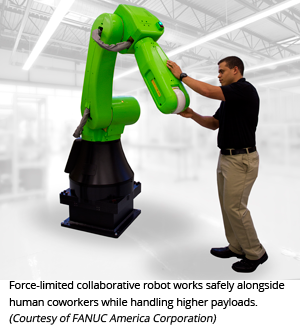
Melton says some of his aerospace customers have expressed interest in the new CR-35iA for load/unload-type applications and CNC machine tending. Late last year, word came from the parent company’s fortress nestled at the base of Japan’s Mount Fuji that FANUC had claimed the world record for the most robot installations. They attribute this accomplishment in part to the popularity of the new collaborate robot.
“If you could have robots able to work in conjunction with the workers out on these aircraft structures, it would be a great fit for it,” says Melton. “It’s more of an investigation right now. Mobile and collaborative robots will grow in the aerospace business.”
Spirit AeroSystems’ Richardson sees huge potential for human-robot collaboration in aerospace manufacturing.
“I’ve been saying for a long time, that’s going to be the game changer for aerospace. We make a tremendous variety of aircraft components at all of our sites. We have such a broad range of product sizes and configurations. Because of that, humans are going to stay critical to the manufacturing processes, especially in our assembly world, where things get so complex. Standard industrial robot technology doesn’t really get us all the way there. We’re interested in software tools like ROS-Industrial to give us additional capabilities to make our automation more adaptable.
“When you have a product life cycle that’s measured in decades, it’s important that you’re leveraging technologies that, when they mature, can be efficiently integrated into your existing manufacturing environment,” continues Richardson. “To me, that’s a perfect recipe for the advancements we’re seeing in collaborative and mobile robots, and tools like ROS-Industrial. I think that’s how we’re going to get there.”
He points out that the idea behind human collaborative robotics is that automation is a productivity tool, not a replacement for people.
“We want to have automation doing what it does best, handling the dull, dirty, dangerous, and most difficult tasks, and allow people to do what they do best, decision-making and directing the work,” says Richardson. “Automation that will give us the biggest bang for the buck will supplement our skilled workforce.”
While HRC and mobile robots are still finding their place in the aviation industry. Other emerging technologies are coming into view.
A Rivet-Free Future?
It seems like light-years since the Wrights’12-second jaunt. A lifetime since Armstrong’s leap for mankind. The aerospace industry only looks back to pay homage. It prefers to look forward.
Just over the horizon, we see new joining technology set to transform aerostructure assembly.
Traditional hard-automation riveter systems used for manufacturing aircraft structures require large, part-specific fixtures to handle the high forces applied during drilling and riveting. These dedicated riveting systems can cost up to $15 million. One technology could spell the end of rivets and costly dedicated riveting systems in aerospace applications.
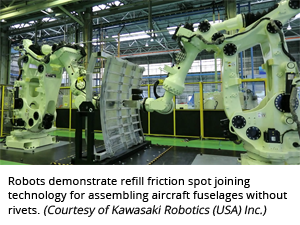 Kawasaki’s new solution uses two highly rigid robots to join fuselage sections (pictured) with either rivets or refill friction spot joining (RFSJ), an innovative metal joining method. Similar to friction stir welding that uses frictional heat and forging pressure to join materials, RFSJ reportedly replaces rivets and fasteners, while creating a sound joint with no head, hole, or indentation. A technical paper on the subject was presented at the SAE AeroTech Congress & Exhibition last September.
Kawasaki’s new solution uses two highly rigid robots to join fuselage sections (pictured) with either rivets or refill friction spot joining (RFSJ), an innovative metal joining method. Similar to friction stir welding that uses frictional heat and forging pressure to join materials, RFSJ reportedly replaces rivets and fasteners, while creating a sound joint with no head, hole, or indentation. A technical paper on the subject was presented at the SAE AeroTech Congress & Exhibition last September.
Development in RFSJ technology and other advanced joining methods for aerostructures has been underway at Wichita State University’s Advanced Joining and Processing Laboratory with the aid of a Kawasaki refill fastening robot donated in 2013. The only other robots of its kind are in Japan.
The new Kawasaki MG10HL robot will be released in the Americas later this year. It boasts a heavy payload capacity of 1000 kg, and has high rigidity and a long reach, making it ideal for high-counterforce aerospace applications. According to the company, the robotic solution greatly simplifies fixturing and provides flexibility for low-volume production in aircraft manufacturing.
For applications requiring higher payloads, a 1500-kg version of the robot will be available. Kawasaki’s original hybrid link mechanism combines the joint 2 (arm out-in) parallel link and joint 3 (arm up-down) serial link configurations to achieve a maximum payload capacity of 1 ton. The second and third axes that affect motion accuracy use highly rigid ball screws with minimal backlash. According to Kawasaki, this reduces arm deflection while enabling high positioning accuracy.
The high rigidity of the Kawasaki MG10HL also allows manufacturers to use a robot for drilling parts instead of a dedicated drill machine, providing increased production flexibility and significant cost savings.
Really, no more rivets? May we offer our condolences. RIP, Rosie. Welcome to aerospace, robotic AM. Additive Manufacturing, commonly called 3D printing, is all the buzz. Robots are turning up the volume. Together they are flipping the aerospace manufacturing model on its head.
Robots + Additive Manufacturing
What happens when you integrate two flexible technologies – additive manufacturing and robotics – into a live demonstration and cart it around the country? You get a tradeshow demo that stops them in their tracks. But you also create a catalyst for ideas, a testbed for complementary technologies, and a building block for new paradigms. It’s a window into the future of manufacturing in the aerospace industry.
The multi-additive robotic cluster developed by aerospace giant Lockheed Martin and RIA Certified Robot Integrator Wolf Robotics has been turning heads on the tradeshow circuit since first launch in 2014. The cluster demonstrates multiple, integrated technologies and how they might be used to manufacture an entire satellite bus in the future.
“Primarily, this cluster was created as a proof of concept and also a demonstration system,” says Jason Flamm, Technical Project Manager at Wolf Robotics, A Lincoln Electric Company in Fort Collins, Colorado. “Now we’re not limited to bringing in raw material and then whittling that down,” making the distinction between subtractive manufacturing and additive manufacturing. “We can essentially start with nothing and build up a structure, and then add pieces as needed.”
The robotic cluster was developed for the Lockheed Martin Space Systems Company in nearby Denver.
“Their vision is to have six or eight robots clustered around a build area, and to have each of those robots performing different manufacturing functions,” says Flamm. It’s Lockheed Martin’s vision for the factory of the future.
As the live exhibit made its way around the country from show to show, Lockheed Martin and Wolf have been incrementally adding components to the system. Each iteration building on the next, demonstrating greater technological possibilities.
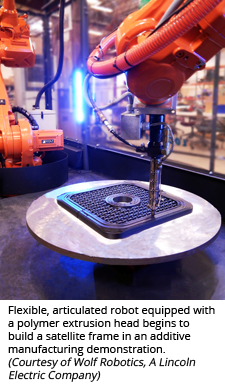 The latest iteration has two ABB robots working in tandem. The first robot is dedicated to the additive manufacturing function. It sports an extrusion head that deposits beads of polymer in continuous motion, layer by layer, as the structure takes shape. The other robot is multifunctional. It uses a tool changer to switch between a machining head to remove excess material, a structured light scanning device to monitor the progress of the build, and a set of grippers to complete various other tasks.
The latest iteration has two ABB robots working in tandem. The first robot is dedicated to the additive manufacturing function. It sports an extrusion head that deposits beads of polymer in continuous motion, layer by layer, as the structure takes shape. The other robot is multifunctional. It uses a tool changer to switch between a machining head to remove excess material, a structured light scanning device to monitor the progress of the build, and a set of grippers to complete various other tasks.
“We also had the robot pick up a smaller desktop 3D printer and place it up against the surface of the structure built by the robot, and then print fine features on it,” says Flamm. “We’re able to do things that you couldn’t do before,” describing how in this latest iteration they incorporated the satellite fuel tank into the structure. “We built up and around the tank in a way that you couldn’t do otherwise. At this last show, there were probably six different tools used by the two robots.”
With traditional equipment, this kind of process occurs in a series. You build, then subtract, then add components. That’s the beauty of marrying robotics and additive manufacturing. All these processes can be done in parallel. In one of the early iterations Wolf introduced a proprietary CAD-to-path software solution into the robotic cluster.
“That’s really what we’ve been able to bring to the table at Wolf Robotics is the engineering and software support to help Lockheed with their vision,” says Flamm. “We tend to work on projects that require more engineering support, whether it’s very large systems for the mining industry or more complicated systems for aerospace. Those markets require greater engineering muscle.”
It’s unusual for a large multinational company like Lockheed Martin to invite the world in to see its technological experiments. Flamm is grateful for the experience.
“At this stage of the game, they have been very open, which is unique for a corporation of their size. They’re saying, ‘Hey, industry, this is where we’re going. This is our vision, come join us.’ It’s been a neat process to be a part of.”
It is neat to be allowed in, even if it is just for a glimpse of a technological leader’s trials and triumphs. To see where we’re going, to see what the industry has in store for us. Not just as manufacturers, integrators, and end users of advanced technologies, but as members of the flying public, something we all have in common.
Author: Tanya M. Anandan, Contributing Editor
Special thanks to Boeing spokesperson Nate Hulings for his contributions.

